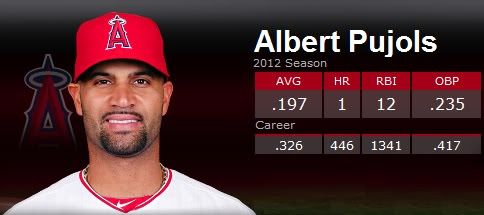![]() Giancarlo Stanton is about to ink a deal of epic proportions.
Giancarlo Stanton is about to ink a deal of epic proportions.
The Miami Marlins are close to signing the 25-year-old outfielder to the richest contract in baseball history: an unprecedented 13 years and a ghastly $325 million. The news was first reported by Jon Heyman of CBS Sports.
![]()
According to Chris Cotillo of MLB Daily Dish, the opt-out clause will come when Stanton is 30.
![]()
The deal is crazy on all kinds of levels. Stanton is coming off an MVP-caliber season in which he hit 37 home runs and 105 RBI while sporting a .288 average, .950 OPS and 6.5 WAR. Not eligible for free agency until after the 2016 season, it was long assumed that Stanton’s days in Miami would come to an end sooner or later.
After all, the Marlins have a history of dealing away their best players, and Stanton had made it clear in the past that he was unhappy with the way the organization had handled things. Just a few months ago, it seemed certain that Stanton would skip town the first chance he got.
Guess things change and differences are set aside when there are $325 million on the table.
It is hard not to question Stanton in the fallout of this news. That is not because he took the money. He has every right in the world to secure those riches, especially after suffering a nearly career-threatening injury at the end of last season when a Mike Fiers fastball hit him square in the face, leaving him with multiple fractures and lacerations.
![]()
It is safe to say Stanton’s life flashed before his eyes there. At the very least, he was reminded that nothing in this game or in life is guaranteed. It would not be surprising if that incident played a role in him taking this deal.
Combine that freak accident with all the zeroes being thrown his way and the notion that Miami was somewhat competitive in 2014, and you have all the answers as to why Stanton would make a deal with the devil—Marlins owner Jeffrey Loria.
What Loria has done throughout his history in baseball is the businessman’s equivalent to the scorched earth policy that the Soviets so famously used against the Germans in World War II. In other words, he has left a trail of nothingness, despair and destruction behind in his wake, all for his own personal success.
Previously an owner of the Montreal Expos, he is a huge reason why Canada only has one major league team now.
![]()
His reign as the ultimate decision-maker in Florida has been disappointing as well. He did bring the franchise its second World Series win in 2003. But from there, Loria tore the team apart. In an effort to slash payroll, Loria traded Josh Beckett, Mike Lowell, Brad Penny, Luis Castillo, Juan Pierre, Alex Gonzalez, Derrek Lee and Juan Encarnacion—all key members of that championship team—over the next two years.
Ivan Rodriguez and A.J. Burnett left via free agency during that span as well. In 2007, the Marlins traded Dontrelle Willis and Miguel Cabrera—now arguably the best hitter in the game—to the Detroit Tigers.
Fans distanced themselves from the franchise. Loria blamed a lot of the team’s problems on its stadium, so he struck a plan to use taxpayer money—the same taxpaying fans he had screwed over by scrapping a winning team—to build a new stadium in Miami.
It was a brand-new start in 2012 with Loria supposedly being a whole new man running things. The Florida Marlins became the Miami Marlins, and they changed their colors and uniforms and moved into the luxurious and expensive Marlins Park in Miami. Keeping his promise of fielding a competitive team, Loria spent $191 million to bring in Jose Reyes, Mark Buehrle and Heath Bell. The Marlins traded for Carlos Zambrano and brought World Series champ Ozzie Guillen in to manage.
Marlins baseball was looking good again.
That would last half a year. Loria had the team trade Anibal Sanchez, Omar Infante and Hanley Ramirez halfway through the 2012 campaign. That offseason, the Marlins shipped Reyes, Buehrle and a handful of others to the Toronto Blue Jays.
Fans had lost all faith and trust in Loria.
Which is exactly why it is so perplexing that Stanton would sign away the prime of his career to a man that lies so much that his pants are surely on fire by now.
![]()
With so much money involved, Stanton’s only way out will be that opt-out clause. If he doesn’t utilize it, then he is stuck in Miami until the end of those 13 years. The question is, will Loria also be willing to pay for and maintain a contender around him?
Based on history, the answer is an absolute no.
For Stanton, there were plenty of reasons to take this deal—dollars being a big one.
However, there are a lot of risks here as well. Loria has never been about winning. Instead, he is all about dollar signs. As long as he is making money, Loria has never cared what the product on the field looked like.
That is probably not the sales pitch he made to Stanton. Instead, there were probably a lot of promises about turning the team around, winning and bringing a new level of excitement to Marlins baseball with the young slugger at the center of it all. Just like he told fans in 2012.
Those were empty promises and lies. For Stanton’s sake, let’s hope that is not the case again.
All stats were obtained via Baseball-Reference.com.
Gary Phillips can be contacted at gary.phillips@student.shu.edu or on Twitter @GPhillips2727.
Read more MLB news on BleacherReport.com

